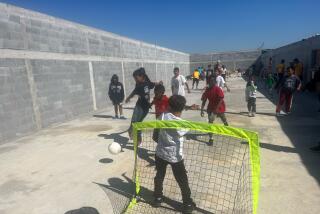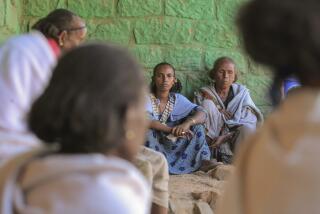POVERTY : A Hand Up, Not Handout, for the Poor : Agency says officials have bungled aid to the needy in rural areas, focusing on trickle-down instead of increased production.
- Share via
UNITED NATIONS — A U.N. report insists that foreign-aid officials have blundered for four decades with programs that failed to deal with the heart of the Third World’s development problem--its vast, dispiriting populations of rural poor.
According to the report from the highly regarded International Fund for Agricultural Development (IFAD), foreign-aid programs tend to focus on encouraging a developing country’s economic growth as a whole, assuming that prosperity will make its way to the rural poor. But, IFAD President Idriss Jazairy said, “trickle-down has not worked--or it has not worked enough.”
Instead, Jazairy, an Algerian who is retiring as president in January, insists that development officials must think of the rural poor themselves as a resource to be encouraged to produce prosperity. This can be done, he says, with small, relatively inexpensive programs that take into account the needs and customs of the poor in the countryside.
“The poverty of nations and the poverty of people are not as easily separable as was often thought in the past,” Jazairy said. “In many cases, it is difficult to envisage national growth without strong economic development among the poor themselves--not as objects, but as subjects of development.”
At stake is a huge proportion of the world’s people. IFAD says 4 billion people live in the world’s 114 developing or Third World countries. More than 2.5 billion live in rural areas. Of these, nearly 1 billion live below the poverty line--633 million in Asia, 204 million in Africa, 76 million in Latin America and the Caribbean, and 27 million in the Near East and North Africa.
Using various indexes, IFAD concluded that five developing countries with the worst-off rural populations are Bhutan, Burkina Faso, Somalia, Mauritania and Sudan. The Somali statistics were compiled before the recent civil war that has ravaged the country. It is almost certainly worse off now.
In many ways, the report’s conclusions and Jazairy’s ideas echoed those advanced by such writers as French agronomist Rene Dumont and U.S. Peace Corps consultant David Hapgood during the 1960s. They argued that development of much of the Third World would depend on small projects that met the needs of poor farmers.
While the Dumont and Hapgood ideas were in vogue for a while, particularly in the Peace Corps, they were usually ignored by major agencies such as the U.S. Agency for International Development in favor of far more spectacular projects that cost much more money.
But IFAD appears to have revived these ideas in its 14 years of existence.
Jazairy said development workers must keep in mind that “the poor are not idle; they work.”
“Nobody is simply poor,” he went on. “The rural poor are poor farmers, poor herders and poor fishermen. In short, they are poor producers: Their incomes are gained from their work. The answer to poverty lies in creating the conditions for them to earn more from their work.”
As an example of what is needed, Jazairy cited a bank project in Bangladesh that made small loans to poor farmers so they can buy needed equipment and fertilizer to increase their production. Jazairy said that despite bankers’ misgivings about making loans to the poor, the repayment rate in this project is almost 100%.
“In IFAD’s experience,” Jazairy said, “the problem is not the ability of the poor to handle credit. Rather, it is the reluctance or inability of existing institutions to provide it.”
Jazairy said the loans are made by “bankers on bicycles” who serve in 850 branches covering 21,000 Bangladeshi villages. Most of the borrowers are women, who do much of the agricultural work in the Third World.
In fact, Jazairy said that development officials need to understand the importance of poor women in rural production. “At present, the contribution of women to the rural economy is seriously underestimated,” he said, calling this “the invisible women syndrome.”
Poorest of the Poor
Here are the 15 worst-off countries in the world. The rankings are based on percentage of rural poor plus factors such as literacy and health care:
% of rural poor rural in 1988 pop. 1. Bhutan 1.2 million 90% 2. Burkina Faso 7 million 90% 3. Somalia 3.2 million 70% 4. Mauritania 900,000 80% 5. Sudan 15.9 million 85% 6. C. African Rep. 1.4 million 91% 7. Bangladesh 82 million 86% 8. Gambia 540,000 85% 9. Guinea 3.5 million 70% 10. Afghanistan 7.1 million 60% 11. Guinea-Bissau 560,000 76% 12. Rwanda 5.6 million 90% 13. Djibouti 55,000 70% 14. Mozambique 7.4 million 65% 15. Sierra Leone 1.8 million 65%
Source: International Fund for Agricultural Development
More to Read
Sign up for Essential California
The most important California stories and recommendations in your inbox every morning.
You may occasionally receive promotional content from the Los Angeles Times.










